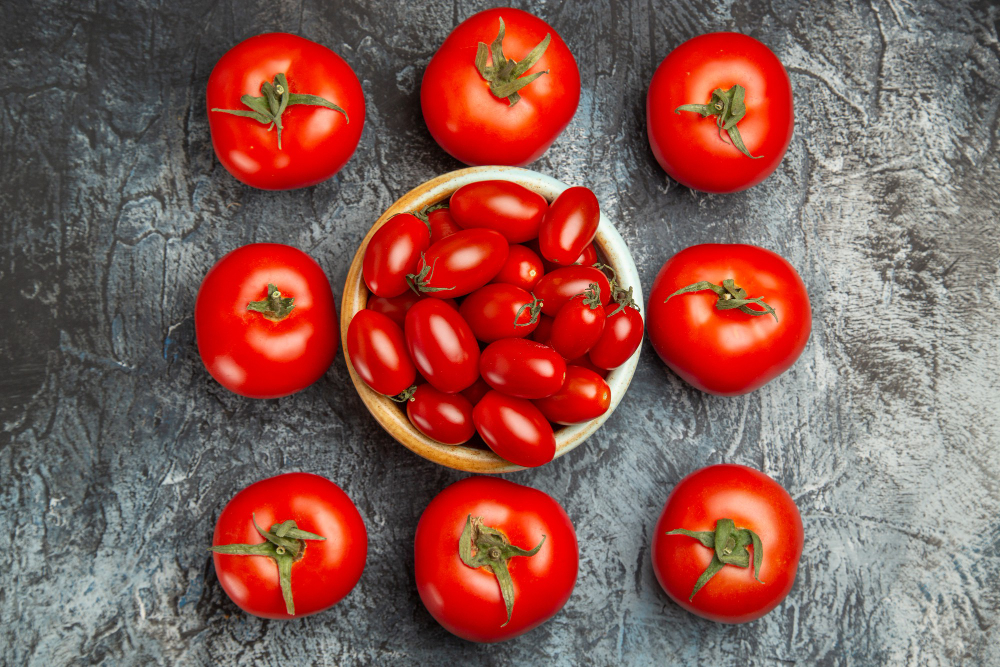Tomatoes serve as a kitchen essential in various regions shaped by different flavors. Notably common are regular and plum tomatoes. Every type provides special features suitable for distinct culinary uses. Although they can look alike at a glance they possess clear distinctions.
Overview of Regular Tomatoes
Varieties of Regular Tomatoes
The most popular tomato variety is regular tomato and it has many different shapes and sizes. Beefsteak and Cherry tomatoes along with Heirloom are among the top varieties. Each variety has its distinct taste as regular tomatoes frequently feature a round shape and juicy consistency which makes them suitable for raw and cooked uses.
Characteristics of Regular Tomatoes
Regular tomatoes usually hold more moisture and rounder shapes than plum tomatoes. Due to their rich moisture content they provide a tingling flavor perfect for salsas and salads. They have a soft texture that promotes eating uncooked or in dishes that carry quick cooking yet create a moist environment.

Common Uses of Regular Tomatoes
Regular tomatoes are useful in many ways. Their juiciness makes them ideal for use in unheated dishes but also performs well in quick-prepared soups and sauces. In salads and on sandwiches as well as in fresh salsas bright acidity distinguishes regular tomatoes which enhance the dish.
Overview of Plum Tomatoes
Varieties of Plum Tomatoes
They come with popular types such as Roma and San Marzano. With less moisture and tighter texture than regular tomatoes they are terrific for cooking especially in sauces.
Characteristics of Plum Tomatoes
The shape of plum tomatoes is generally elongated and usually they are not as large as regular tomatoes. Due to having thicker flesh and a reduced number of seeds they develop a concentrated flavor. The reduced water volume indicates that plum tomatoes retain their form more easily with higher heat resulting in ideal choices for sauces and sluggish cooking.
Common Uses of Plum Tomatoes
In cooking and sauces plum tomatoes play a significant role. Firm and flavorful tomatoes offer an excellent choice for making sauces that remain thick and solid in a long cooking process. They can either be roasted or canned to great effect.

Nutritional Differences
nutritional comparison between regular tomatoes and plum tomatoes :
| Nutrient | Regular Tomatoes (per 100g) | Plum Tomatoes (per 100g) |
| Calories | 18-22 calories | 11-15 calories |
| Water Content | High (about 94%) | Moderate (about 90%) |
| Fat | 0.2 grams | 0.1 grams |
| Carbohydrates | 4.8 grams | 2.4 grams |
| Dietary Fiber | 1.5 grams | 1 gram |
| Vitamin C | 20 mg | 23 mg |
| Vitamin A | 1025 IU | 833 IU |
| Potassium | 237 mg | 290 mg |
| Lycopene | 3 mg | 4–5 mg |
Key Points:
- Calories: Though both are quite low in calories regular tomatoes contain a touch more calories as their water content is slightly higher.
- Lycopene: The greater lycopene in them enhances heart wellness and provides antioxidant advantages.
- Potassium: They have a greater amount of potassium that is crucial for regulating blood pressure.
Nutrient Content in Regular Tomatoes vs Plum Tomatoes
Regular and plum tomatoes are packed with vitamins A and C; yet plum tomatoes have more nutrients due to their fewer watery contents. They act as an excellent choice for individuals wishing to increase their consumption of antioxidants and lycopene for its well-known anti-cancer effect.
Health Benefits of Regular Tomatoes
The high concentration of vitamin C in regular tomatoes supports your immune function while keeping your skin vibrant. With their abundant water content they are satisfyingly refreshing and hydrating when eaten fresh.
Health Benefits of Plum Tomatoes
With their substantial flesh and distinctive flavor plum tomatoes effectively bolster heart health through their abundance of lycopene and other antioxidants. These contain a denser nutrient mix that explains their common preference for use in cooking.
FAQs
What is the best way to use them?
When preparing sauces or dishes cooked at a leisurely pace plum tomatoes achieve their best due to their intense flavor and solid texture.
Are they healthier than regular tomatoes?
Due to their reduced water level plum tomatoes pack a denser nutrient profile than regular tomatoes.
Can you substitute regular tomatoes for plum tomatoes in recipes?
Still the finished texture could turn out softer if you substitute regular tomatoes instead of plum tomatoes in the sauce.
How do they taste compared to regular tomatoes?
They provide a sweeter taste and increased concentration; regular tomatoes are juicier and include a slighter acid taste.

Which type of tomato is better for sauces, plum or regular?
Plum tomatoes are preferred for sauces due to their thicker flesh and concentrated flavor.
Can I grow plum tomatoes at home?
Yes, they can be grown at home, though they require specific growing conditions similar to other tomato varieties.
contact us if you have any queries.




